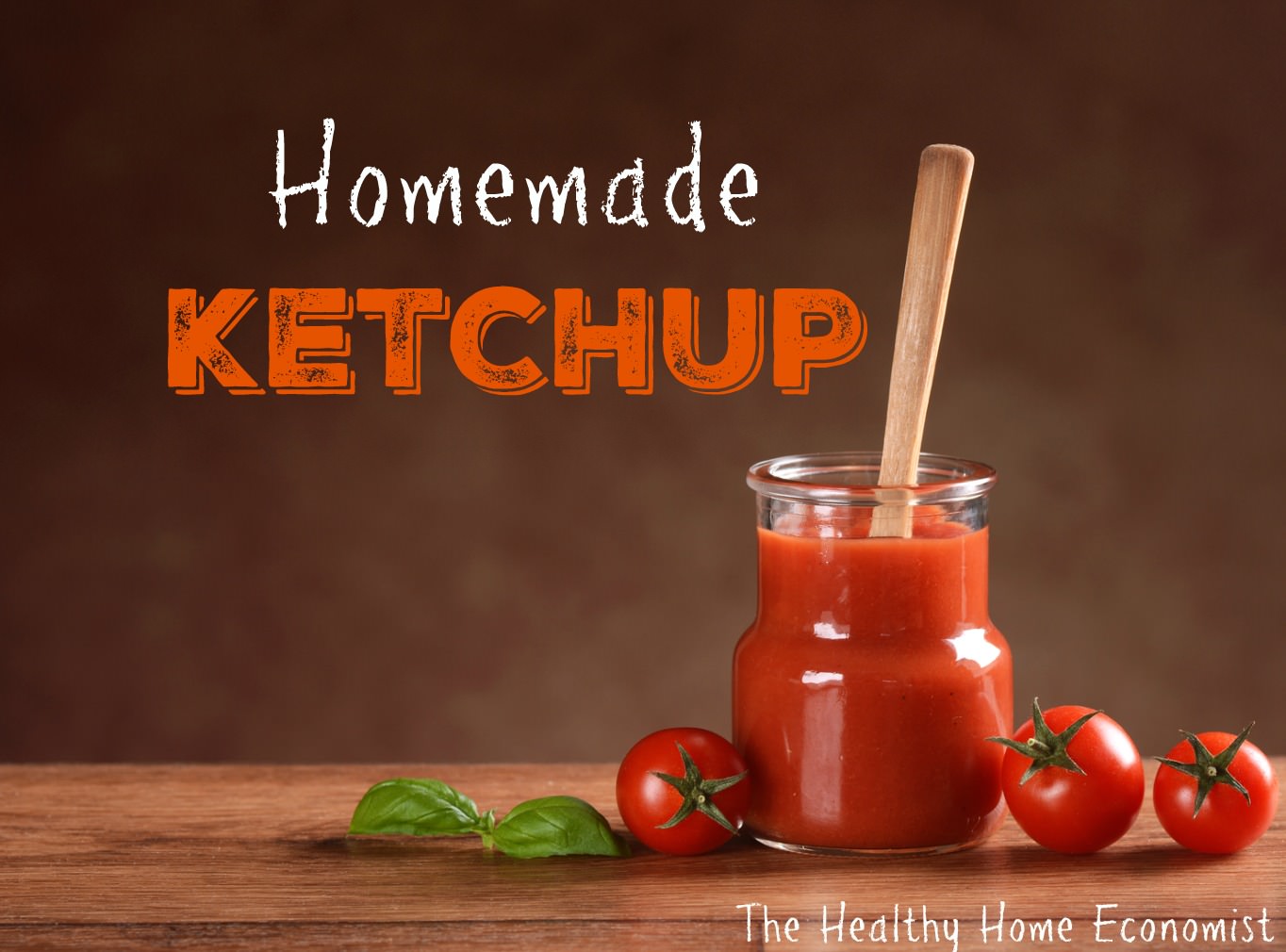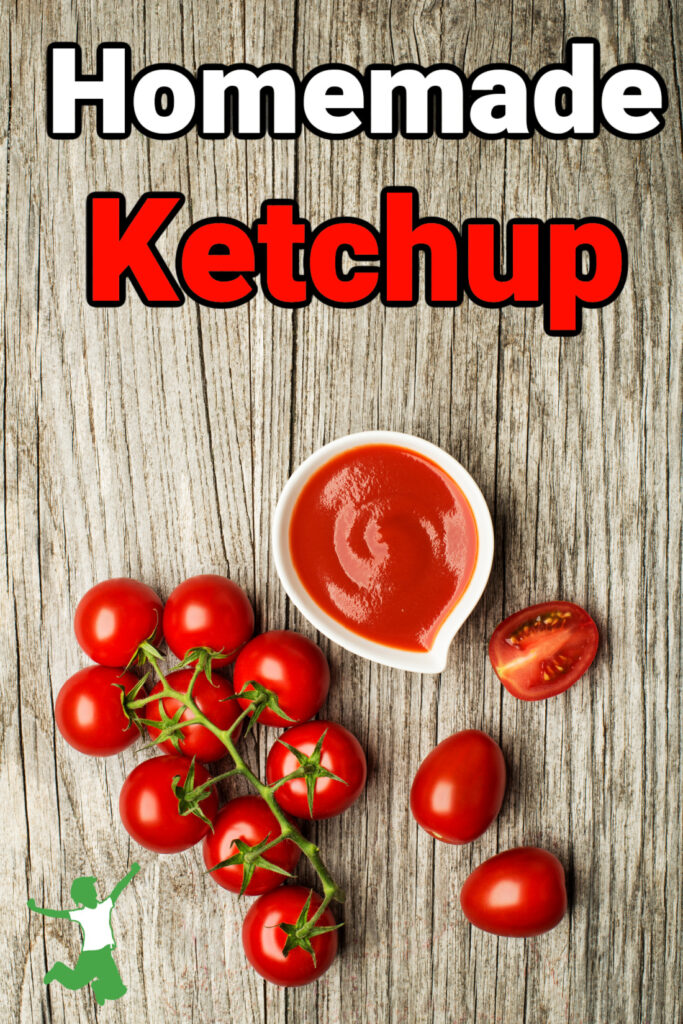Fermented ketchup recipe that is lightly cultured for a healthy condiment that deliciously adds probiotics and enzymes to any meal.

The king of condiments in the Western world is undoubtedly ketchup. Americans buy over a half billion bottles of ketchup every year.
Unfortunately, food manufacturers use GMO high fructose corn syrup as the sweetener of choice — definitely not part of a healthy diet! Organic versions frequently contain sugar and are expensive. Hence, many health conscious households are seeking to make homemade ketchup as a nutritious alternative.
Ketchup originally comes to us from China as a fermented fish sauce. It is definitely a traditional condiment used for centuries as part of healthy ancestral diets.
In the modern era, Americans added tomatoes to make the world famous tomato ketchup of today.
The ketchup recipe below is lightly fermented using the Nourishing Traditions method.
This process utilizes beneficial bacteria to quickly and safely transform the ingredients into an enzyme rich, probiotic filled condiment.
Using these “live” foods greatly assists digestion when used in conjunction with a meal of cooked foods. Bring on the grassfed burgers and homemade French fries.
It is important to learn how to make healthy homemade ketchup for your family. If you simply don’t have the time, at least consider purchasing quality ketchup without GMOs.
This brand sweetened with honey and this no-sugar ketchup brand are both good options if you prefer to buy.
The video included with the recipe below demonstrates how to make ketchup at home. My husband finds it helpful for improving digestion and reducing bloating when eaten with a meat based meal.
I also use it as a base for other condiments like thousand island dressing or fermented barbecue sauce.

Easy Homemade Ketchup Recipe
Lightly fermented, delicious tasting homemade ketchup recipe to add probiotics and enzymes to any meal.
Ingredients
- 3 cups tomato paste preferably organic packed in glass jars
- 1/4 cup liquid whey
- 1/4 – 1/2 cup maple syrup dark
- 3 cloves garlic crushed, preferably organic
- 1 Tbl sea salt
- 1/2 cup fish sauce
- 1 pinch cayenne pepper optional
Instructions
-
Mix all ingredients together in a clean, wide mouthed mason jar.
-
Leave at least one inch at the top of the jar to allow for expansion during the fermentation.

-
Leave on the counter for 2 days and then refrigerate.
-
The ketchup is well preserved for about 6 months.
Recipe Video
Recipe Notes
Use 1/4 tsp cayenne pepper for a more powerful tasting ketchup.
Make sure the fish sauce you use contains ONLY anchovies and salt as the listed ingredients. Many brands contain MSG and/or added sugar.

More Fermented Condiments Recipes








I have a question: does the lacto fermentation process change the taste? Would this taste different if you ate it before letting it sit out? Or is that not a good idea?
Yes, fermenting it does improve the flavor. You can use it right away of course, but letting it sit will both improve flavor and nutrition by adding much needed enzymes.
Hi Anonymous, it would last a few months. I've always used it up long before this point.
Hi Sarah,
I have been following your blog,for some time now,must say u are doing a wonderful job.I would like to know, how long this home-made ketchup would last in fridge?
Sarah – this recipe is amazing. Thank you so much for sharing. Mmmm.
Hi Andrea, I just made a batch that was finished fermenting yesterday and no, mine does not get bubbly. I've not ever noticed my ketchup get bubbly as a matter of fact. It does taste fermented though which adds a lot of flavor to it. How does yours taste?
Hi Sarah, I tried making the NT ketchup recently and it didn't get all bubbly and fermented- does yours? There was nothing wrong with my whey- used the same batch as I did for ginger carrots and it fermented great with that. My fish sauce was just cured anchovies and salt, and I think all my other ingredients were fine. Any insight?
Hi Sherry, please email me at The Healthy Home Economist (one word) AT gmail DOT com and I would be happy to answer all your questions about my local WAPF Chapter.
Yes, whey from clabbered milk, yogurt, and kefir are all fine.
Can you use ACV INSTEAD if whey.
Yes. Here’s some guidelines on that. https://www.thehealthyhomeeconomist.com/dairy-free-fermentation-no-whey/
Does the whey need to come from raw milk? Can whey from kefir be used for this?
Sara,
A friend had sent me a link to your Blog. I have been reading it for a couple of days now. For many years I have been confused on what I should and should not be eating. I have tried so many different eating plans/diets and products (supplements and alternative holistic approach) try the plan and then switch to sometime else. I still eat and serve processed foods and want to make the switch but need help on how to do this. It can be so overwhelming. In my heart… I am ready but don’t know how or where to start. Also, I have been confused with all the information out in our media on whether it is good or not good to eat meat. I was pleasantly surprised to read on the WAPF website and find out that it is OK to eat meat and that animal products provide vital nutrients not found in plant foods. But where do you buy healthy meat in Tampa??
On the WAPF your name was listed as the Tampa Charter for the local WAPF. How does the local charter work? I am looking for help and support on how to slowly switch over to a healthy plan for myself and my family.
Any suggestions you can provide would be fantastic. Do you have local meetings or a support group?
Thanks for your time,
Sherry